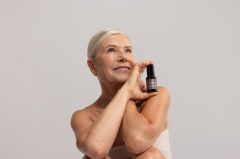Discover how hormonal changes affect your skin in perimenopause and menopause, and how targeted, science-backed care supports smart ageing.
There’s a moment, often subtle at first, when your skin doesn’t quite behave the way it used to. The glow feels dimmer. Makeup sits differently. Products that once worked wonders suddenly fall flat. Welcome to the hormonal shift that is perimenopause – a biological milestone that changes not just how you feel, but how your skin functions.
For years, conversations about menopause focused on hot flushes and mood swings. But beneath the surface, one of the most profound shifts occurs in your skin. As oestrogen and progesterone levels fluctuate, so does the architecture of your complexion. Collagen – the protein responsible for firmness and bounce – declines by as much as 30 per cent in the first five years after menopause. The skin barrier becomes thinner, drier and more reactive. You may notice redness where there was once calmness or fine lines that seem to deepen overnight.
This isn’t just “ageing” … It’s hormonal ageing. And it requires a different conversation.
When “anti-ageing” misses the point
Traditional anti-ageing formulas were designed to tackle wrinkles and pigmentation, but they rarely considered the hormonal landscape beneath. During perimenopause and menopause, skin physiology changes at a cellular level. Your skin’s oil production drops, hydration decreases and your pH becomes less acidic, weakening its natural defences.
Meanwhile, glycation – the process where sugar molecules bind to collagen and elastin, stiffening them – accelerates. This internal “caramelisation” makes the skin less supple and more prone to dullness. Add to this the stress hormone cortisol, which rises in midlife and further compromises barrier repair, and you have the perfect storm for sensitivity, dryness and inflammation.
The answer isn’t to fight ageing – it’s to work with it supporting your skin through perimenopause and its hormonal evolution with targeted, science-backed care.
That’s where Synergie Skin steps in.
The science of hormonal skin support
Certain ingredients have emerged as game-changers in this area of skin science, offering specific support for oestrogen-deprived skin.
Soy isoflavones are phytoestrogens – plant-based compounds that mimic the effects of oestrogen in the skin. Studies show they help boost collagen synthesis and improve elasticity, making them ideal for restoring firmness during menopause.
Pink microalgae is another powerful ally for your skin. Rich in antioxidants and natural peptides, it works to defend against glycation – the invisible culprit behind the loss of youthful resilience.
Carnosine, a naturally occurring dipeptide, offers dual protection: it neutralises free radicals and inhibits glycation, effectively slowing the cascade of oxidative stress that accelerates visible ageing.
Together, these three potent ingredients repres





